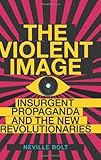The violent image : insurgent propaganda and the new revolutionaries / Neville Bolt.
Material type: TextLanguage: Eng Publication details: New York : Columbia University Press, c2012.Description: xxvii, 429 p. : ill. (chiefly col.) ; 23 cmISBN:
TextLanguage: Eng Publication details: New York : Columbia University Press, c2012.Description: xxvii, 429 p. : ill. (chiefly col.) ; 23 cmISBN: - 9780231703161 (alk. paper)
- 9780231800884
- 303.3/75 23
- JC328.5 .B65 2012
| Item type | Current library | Home library | Collection | Shelving location | Call number | Vol info | Copy number | Status | Date due | Barcode |
|---|---|---|---|---|---|---|---|---|---|---|
 Libro
Libro
|
Biblioteca Juan Bosch | Biblioteca Juan Bosch | Ciencias Sociales | Ciencias Sociales (3er. Piso) | JC328.5 .B65 2012 (Browse shelf(Opens below)) | 4 | 1 | Available | 00000103295 |
Browsing Biblioteca Juan Bosch shelves, Shelving location: Ciencias Sociales (3er. Piso), Collection: Ciencias Sociales Close shelf browser (Hides shelf browser)

|

|

|

|
No cover image available |

|
No cover image available | ||
| JC 328.3 V566c 2013 Contra quiénes luchar / | JC 328.3 V566r 2002 R : rebeldes, revolucionarios y refractarios : ensayos sobre la disidencia / | JC 328.3 V566r 2012 R : rebeldes, revolucionarios y refractarios : sistema, subsistemas, y antisistemas / | JC328.5 .B65 2012 The violent image : insurgent propaganda and the new revolutionaries / | JC 328.5 B663m 2005 The marketing of rebellion insurgents, media, and international activism / | JC 328.5 C733i 2007 L'insurrection qui vient / | JC 328.5 O52c 2009 Civil wars : internal struggles, global consequences / |
Includes bibliographical references (p. 271-415) and index.
Introduction. What is Propaganda of the Deed (POTD)? -- Overview -- Different ways of reading POTD -- The terrorist act as communicator -- Archipelago of memories -- Insurgent memory and narrative -- The insurgent image -- Television memory -- Where the imaginary meets the virtual -- Spontaneous revolution -- The new strategic operating concept -- Conclusion.
Fast-moving, self-perpetuating images of violence have radically changed the nature of insurgency in modern times, and the global media trafficking in these images have fundamentally transformed the act and speed of the exchange among populations. First satellite TV, then laptops and the Internet, and now cellphones and social media, new technologies have revolutionized the act of communication and have collapsed the impediments of time and distance. Rebels who hope to overthrow states and revolutionaries who aim to establish transnational, ideological communities have only to utilize these dynamic technologies to advance their goals. Yet trial and error has also taught a key lesson: in a visual world, the pull of the violent image is more powerful and resonant than the draw of the carefully-crafted word. Neville Bolt dives headfirst into the innovative strategies of today's revolutionaries and their fascinating appropriation of the nineteenth-century practice of "propaganda of the deed," or the political act of violence. No longer is the terrorist act simply a means to push governments to overreact, therefore shredding their legitimacy and credibility. The deed has instead become an efficient tool to initiate a campaign of shock and awe, exposing and exploiting the grievances that underlie communities' fragile ties. Images of 9/11, 7/7, Abu Ghraib, and "collateral damage" are the contemporary weapons of choice. The Violent Image explores the emotional and psychological components of this visual "moment of shock," or the binding of emotive pictures to messages causing popular uprisings. From terrorist groups such as the Fenians and the Taliban to the architects of the ongoing Arab Spring, this study follows insurgents and their manipulation of violent imagery to build narratives and bring social change. Taking advantage of the "war of ideas," new revolutionaries generate surges of support that spread virally through global networks, often so quickly that states are unable to respond in time and kind. This book ultimately asks whether the world has reached a point in which insurgents and populations are driving images and ideas so rapidly that we are already in the grip of a new era of revolutionary politics


There are no comments on this title.